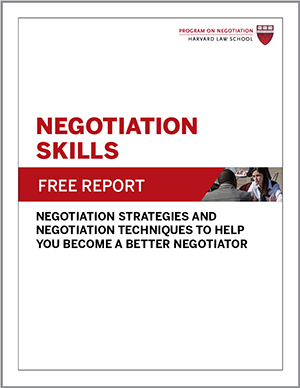Q: I lead a team of approximately 50 lawyers in the in-house legal department of a Fortune 500 company. As our team gets larger, reflecting the company’s growth, I’d like to install quality-control measures to ensure that all our attorneys are effectively negotiating settlements when appropriate and taking cases to trial when not. What are the best practices for coordinating teams and doing this?
Coordinating Teams that Negotiate
A: You raise the important question of how to disseminate effective negotiation skills throughout your organization and start coordinating teams. The first step is to pick a negotiation framework, such as the “Seven Elements” framework popularized by Getting to Yes: Negotiating Agreement Without Giving In (Penguin, 2011) co-authors Roger Fisher, William Ury, and Bruce Patton, and detailed in Fisher and Danny Ertel’s workbook Getting Ready to Negotiate (Penguin, 1995). A framework provides a systematic approach to negotiation, which we all know is vital, and it ensures that your attorneys are not missing a critical piece of analysis before they go to the table.
Most frameworks, including the Seven Elements framework, provide equal space on their worksheets to analyze both your side and the other side. This feature is not just for visual symmetry; rather, it forces your attorneys to consider the other side’s perspective with the same care and objectivity as they consider their own. If your attorneys come to you with a lot of information on your side of the page but a lot of white space on the other party’s side, this will be a powerful visual reminder that they need to do more homework before going to the table.
Once you’ve chosen a particular framework, the second step is to customize it for your purposes. As you look through the various components, consider whether there are elements that are not relevant to your context or others you might want to add. For example, in my executive-education classes, I advise negotiators to anticipate and even role-play the most difficult question they may be asked. This is not an explicit component of the Seven Elements framework, but it could allow your attorneys to avoid land mines in the room.
The third step is to get buy-in for the framework from your attorneys. The danger here is that your attorneys will ignore the framework or, even worse, fill it out in a perfunctory way just to appease you. Consider holding an off-site meeting where you would propose your framework and your attorneys would make adjustments as needed. By the end of the meeting, everyone should agree that the framework, as adjusted, is worth trying. In my experience, this buy-in step is the most important part of the process.
Once your preparation framework has launched, insist that your attorneys brief you using the framework before beginning any important negotiation. A good preparation framework isn’t just a good negotiating tool; it’s an effective coaching and mentoring tool as well. Check in with your attorneys individually and collectively throughout the negotiation process to monitor progress and make further adjustments as needed.
Finally, consider holding post-negotiation reviews (PNRs) with your team, maybe once a month or even once a week, where attorneys can report back on recently completed negotiations. PNRs can be powerful learning tools but only if there is sufficient “psychological safety” within the group such that attorneys can be candid about things they would have done differently. After all, we love to talk about our successes, but we learn the most from our failures. A PNR process not only ensures continual improvement but also causes your attorneys to negotiate better in the room because they know they will later have to explain their decisions and their actions to the rest of the team.
Guhan Subramanian
Faculty Chair, Program on Negotiation at Harvard Law School
Joseph H. Flom Professor of Law and Business, Harvard Law School
H. Douglas Weaver Professor of Business Law, Harvard Business School
Faculty Chair, J.D./M.B.A. Program, Harvard University




